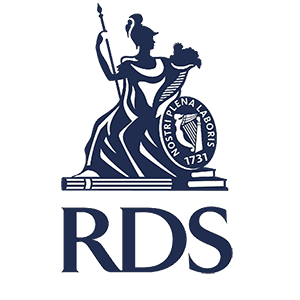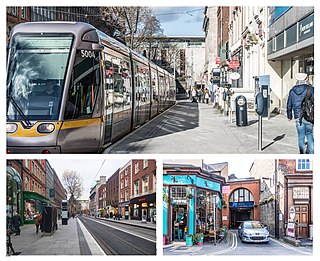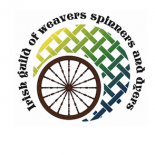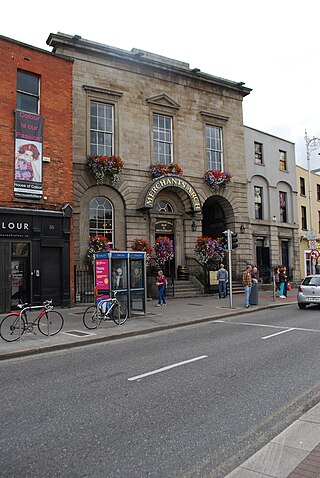
The National Museum of Ireland is Ireland's leading museum institution, with a strong emphasis on national and some international archaeology, Irish history, Irish art, culture, and natural history. It has three branches in Dublin, the archaeology and natural history museums adjacent on Kildare Street and Merrion Square, and a newer Decorative Arts and History branch at the former Collins Barracks, and the Country Life museum in County Mayo.

St Stephen's Green is a garden square and public park located in the city centre of Dublin, Ireland. The current landscape of the park was designed by William Sheppard. It was officially re-opened to the public on Tuesday, 27 July 1880 by Lord Ardilaun. The square is adjacent to one of Dublin's main shopping streets, Grafton Street, and to a shopping centre named after it, while on its surrounding streets are the offices of a number of public bodies as well as a stop on one of Dublin's Luas tram lines. It is often informally called Stephen's Green. At 22 acres (8.9 ha), it is the largest of the parks in Dublin's main Georgian garden squares. Others include nearby Merrion Square and Fitzwilliam Square.

Cork Opera House is a theatre and opera house in Cork in Ireland. The first venue opened in 1855 on Emmet Place to the rear of the Crawford Art Gallery. This original building was destroyed by fire in 1955, and a replacement opened in 1965. With a number of additions in the early 21st century, the 1000-seat venue hosted over 100 theatre, music, opera, and comedy events in 2015.

The Royal Dublin Society (RDS) is an Irish philanthropic organisation and members club which was founded as the 'Dublin Society' on 25 June 1731 with the aim to see Ireland thrive culturally and economically. The RDS is synonymous with its 160,000 m2 campus in Ballsbridge, Dublin, Ireland. The premises include the 'RDS Arena', 'RDS Simmonscourt', 'RDS Main Hall' and other venues which are used regularly for exhibitions, concerts and sporting events like the Dublin Horse Show or Leinster Rugby games. The Royal Dublin Society was granted royal patronage in 1820 by George IV. The RDS Members' Club is a members-only club offering exclusive access to sports events on its premises and weekly luncheons and dinners.

The Liberties is an area in central Dublin, Ireland, located in the southwest of the inner city. Formed from various areas of special manorial jurisdiction, separate from the main city government, it is one of Dublin's most historic working class neighbourhoods. The area was traditionally associated with the River Poddle, market traders and local family-owned businesses, as well as the Guinness brewery, whiskey distilling, and, historically, the textiles industry and tenement housing.

Dawson Street is a street on the southern side of central Dublin, running from St Stephen's Green to the walls of Trinity College Dublin. It is the site of the residence of the Lord Mayor of Dublin, the Mansion House.

John Nost was a Flemish sculptor who worked in England in the late 17th and early 18th centuries.

The Coombe Hospital is a voluntary teaching hospital providing a range of medical services to both women and newborn infants in Dublin, Ireland. It is managed by Dublin Midlands Hospital Group.
Pimlico is an inner city area of Dublin, Ireland on the southside in Dublin 8. It lies between Thomas Court and Ardee Street. At the Thomas Court end of Pimlico is Pimlico Cottages. It is close to the St. James's Gate Guinness Brewery. Similar to other areas of Dublin's Liberties, such as The Coombe, Pimlico was historically home to families of weavers many of whom had emigrated from France via London.

The Coombe is a historic street in the south inner city of Dublin, Ireland. It was originally a hollow or valley where a tributary of the River Poddle, the Coombe Stream or Commons Water, ran. The name is sometimes used for the broader area around, in which the Poddle and its related watercourses featured strongly.

St Mary's Hall is a municipal building in Bayley Lane in Coventry, West Midlands, England. It is a Grade I listed building.

The Apothecaries' Hall of Ireland is one of only two extant successors of a medieval Dublin guild. Apothecaries in Dublin were first organized as members of the 1446 Guild of Barbers, with St Mary Magdelene as the patron saint. In 1747, Apothecaries formed their own guild, with St Luke as the patron. In 1791, the Company of Apothecaries’ Hall was formed for the purposes of building their own Hall and regulating practitioners throughout Ireland. Although the Company ceased licensing doctors in 1971, it continues to exist as a charitable organisation. The Company of Apothecaries’ Hall now shares premises with the Royal College of Physicians of Ireland on Kildare Street, Dublin.

John van Nost the younger (1713-1780) was the nephew of the noted Flemish-born British sculptor John van Nost and a noteworthy sculptor in his own right.

The Irish Guild of Weavers, Spinners, and Dyers (IGWSD) is an organisation for the promotion and preservation of hand weaving, spinning and dyeing in Ireland.

Tailors' Hall is the oldest of two surviving guildhalls in Dublin, Ireland. It is located on Back Lane, off High Street, in the part of the city known as the Liberties. Aside from meetings of its own and many other of the guilds of Dublin, the hall has hosted many social, cultural and educational events. It has been used as a court-house, a barracks, a school, a place of worship and in place of Dublin's City Hall. It was also a meeting place of the United Irishmen, and the site of the Back Lane Parliament. The Tailors' Guild having fully released it by 1873, the building hosted a Christian Mission and later the Legion of Mary. The building having become uninhabitable by the mid-20th century, the Irish Georgian Society launched a restoration campaign in 1966, and it was reopened in 1971. It now holds the headquarters of Ireland's national heritage charity, An Taisce, and can be visited, and rented for events.

The Guilds of the City of Dublin were associations of trade and craft practitioners, with regulatory, mutual benefit and shared religious purposes. In their eventual number they were sometimes called the "25 minor corporations", in contrast to the city's principal authority, the Dublin Corporation). They operated in various forms from near the time of the Norman invasion of Ireland - the Merchants’ Guild existed in some form by 1192 - until the mid-19th century, and a few of which have descendent operations to the present day.

Merchants' Hall is a former 19th century guildhall, now a protected structure, on Wellington Quay in Dublin, Ireland. It is located opposite the Ha'penny Bridge and backs on to Temple Bar. The building was the last of the city guildhalls to be constructed and only operated as a guildhall for a period of 20 years before ceasing as the Merchants' Guild ended its main work, along with the other Guilds of the City of Dublin.

Cuffe Street is a street in Dublin, Ireland which runs from St Stephen's Green at the eastern end to Kevin Street Lower at the western end.

Seán McDermott Street is a street in northeast Dublin, Ireland. It is divided into Seán McDermott Street Lower and Seán McDermott Street Upper.



















